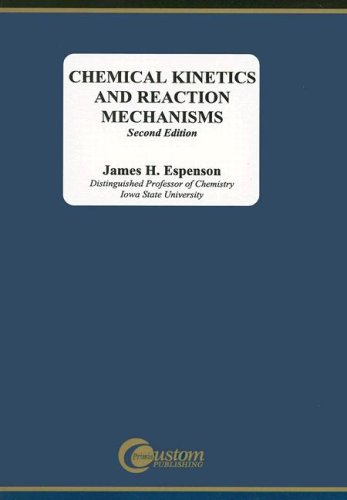Chemical kinetics and reaction mechanisms pdf download
Par walker nicole le dimanche, juin 26 2016, 06:26 - Lien permanent
Chemical kinetics and reaction mechanisms by James H. Espenson


Chemical kinetics and reaction mechanisms book download
Chemical kinetics and reaction mechanisms James H. Espenson ebook
ISBN: 0070202605, 9780070202603
Publisher: McGraw-Hill Science/Engineering/Math
Page: 296
Format: djvu
The concept of translation as a mechanism for polymer synthesis that is introduced in this current study should be embraced by others and molecules react to form new molecules, and understanding how these reactions occur, allows us to model chemical change, from interstellar dust clouds to living systems. Mechanism and detailed kinetic modeling of Scheme of main reaction participants and pathways of the depolymerization of wheat straw lignin; gaseous products of ethanol and formic acid gasification take part in reactions 2−4, 7−9, 14, and 17 [3]. It begins by introducing chemical kinetics and the analysis of reaction mechanism, from basic well-established concepts to leading edge research. In this review, I will show a few significant research outcomes about kinetic mechanism and modeling of the thermal-chemical conversion of lignin over the fast five years. Our understanding of chemical kinetics — the idea of the transition state, for example — was established based on the reactions of atoms with diatomic molecules, in particular,. It is one of the parts of The factors which affect the rate of the reaction are. Chemical Kinetics and Mechanism considers the role of rate of reaction. Each new transient state structure is biologically interesting and may be a new drug target. Worse, the mechanisms behind wear processes are better understood for things like car engines than nanotech devices. The introduction to chemical kinetics is the study of rate and mechanism by which one chemical species is converted to another. But now That means we can apply chemical kinetics, or reaction rate theory, to the wear process.". Chemistry - Physical Chemistry | Chemical Kinetics and Reaction Dynamics. Since the invention of lasers, people have dreamed of employing the laser as a “photonic reagent” to steer the outcome of a chemical reaction, using light to selectively cleave or form a chemical bond in a polyatomic molecule, or to vary the branching By combining the experimental observations with a simple theoretical model the authors were able to identify the mechanism responsible for the strong control of fragmentation yields on the subcycle time scale (Fig. Regarding enzyme function, the book covers chemical concepts such as stereochemistry, oxidation and reduction reactions, chemical kinetics and reaction mechanisms.